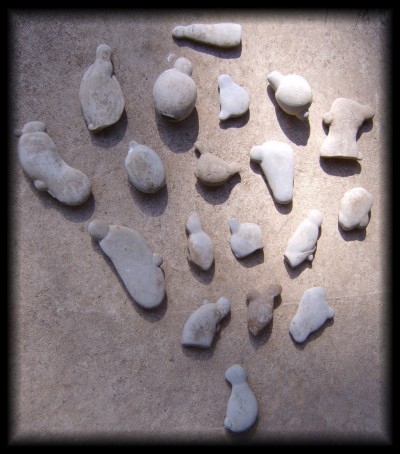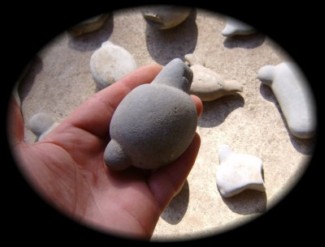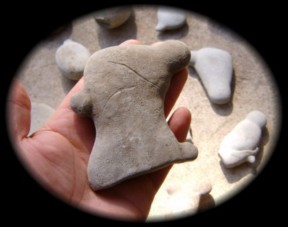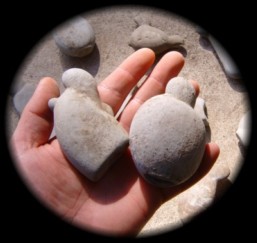Clay Babies
By Don Edgers, Fox
Island Author & Historian
 If one were to look up the word claybaby or the
words clay baby in the dictionary, the result
would be zero. A similar search on Google or other
search engines on the Internet would get the
response: “686 results for ‘claybaby,’” with none
being the unique rock found on Fox Island.
A message off to the right of the computer screen
says, “Looking for claybabies? Find them on eBay.”
Wrong again. Of the 70+ listings, there are some
pretty bizarre looking man-made creations, but not
the one-and-only Mother Nature-created claybaby
(the rock) of Fox Island.
If one were to look up the word claybaby or the
words clay baby in the dictionary, the result
would be zero. A similar search on Google or other
search engines on the Internet would get the
response: “686 results for ‘claybaby,’” with none
being the unique rock found on Fox Island.
A message off to the right of the computer screen
says, “Looking for claybabies? Find them on eBay.”
Wrong again. Of the 70+ listings, there are some
pretty bizarre looking man-made creations, but not
the one-and-only Mother Nature-created claybaby
(the rock) of Fox Island.
According to amateur geologists that I’ve
talked to, our claybabies are concretions, which are
defined as, “a rounded mass of mineral matter
found in sedimentary rock (or – in the case of clay,
material with extremely small grains).” Clay is
“fine-grained, firm earthy material that is plastic
when wet and hardens when heated, consisting
primarily of hydrated silicates of aluminum.”
Whereas our concretions fit the definition above,
claybabies differ from others because there is no
particular nucleus (similar to candy jawbreakers)
because the mass is formed on the clay deposits on
the beach. Large veins of high quality clay extend from banks on the Island well
out onto the beach in the area of the Brickyard and is exposed to waves, tidal
action and the sun on the south (warm side) of Fox Island which are the perfect
ingredients needed to create unusual projections to form on many of our
Brickyard concretions, thus creating a handiwork that is rarer than gold or
diamonds.
 These rock treasures are then scattered from their source by winter
storm wave action to the eastern tip of the Sandspit and to the west as far as
the Navy Barge and beyond. The claybabies, when dislodged from the clay source
are burnished by other beach rocks to become perfectly smooth on both sides.
Each Fox Island claybaby is unique. To paraphrase a credit card company, “Fox
Island’s Claybabies are priceless – for everything else there’s Mastercard®.”
These rock treasures are then scattered from their source by winter
storm wave action to the eastern tip of the Sandspit and to the west as far as
the Navy Barge and beyond. The claybabies, when dislodged from the clay source
are burnished by other beach rocks to become perfectly smooth on both sides.
Each Fox Island claybaby is unique. To paraphrase a credit card company, “Fox
Island’s Claybabies are priceless – for everything else there’s Mastercard®.”
Where do Claybabies come from?
 In the latter part of the 19th century one of Fox Island’s largest and
long-lasting (over 25 years) industries was established between the Sandspit and the Navy Barge (Acoustics Testing Range) and beyond
called the Fox Island Brick Manufacturing Company. This area of
the Island is referred to by Fox Islanders as the brickyard.
“Starting in 1884 (the company) began the manufacture of bricks,
tile, sewer pipe and other clay products. — As many as fifty men
were employed and about ten to fifteen thousand brick were
manufactured per week. — ‘There was a big building containing the
five kilns for making brick.
In the latter part of the 19th century one of Fox Island’s largest and
long-lasting (over 25 years) industries was established between the Sandspit and the Navy Barge (Acoustics Testing Range) and beyond
called the Fox Island Brick Manufacturing Company. This area of
the Island is referred to by Fox Islanders as the brickyard.
“Starting in 1884 (the company) began the manufacture of bricks,
tile, sewer pipe and other clay products. — As many as fifty men
were employed and about ten to fifteen thousand brick were
manufactured per week. — ‘There was a big building containing the
five kilns for making brick.
There were railroad tracks and cars on
roadbeds around the sides of the hill. There was a chute down which
the clay was poured. There was a tall smokestack in the center of the
grounds, a wharf at which boats could land to haul the bricks to market, and a
row of houses along the beach in which the workers lived.’ — There was a dock,
about eight-hundred feet long, about thirty feet from and parallel to the beach.
Although there is still a good supply of clay in the area, production declined
because of a slowdown in the growth of Tacoma, a shift toward the use of
concrete in building construction, and an increase in the cost of firewood,
which had to be transported over greater distances.”
Beachcomber Booty
 "In An Island In Time: Growing up in the 1940s", Chapter 6,
‘The Sandspit – 1942’, I tell about a typical picnic which includes
beachcombing for all the usual flotsam and jetsam, but includes
unusual rocks found only on the southwest side of Fox Island –
claybabies. “We looked for claybabies. The more east we looked,
the more abundantly they appeared – twins, triplets, quadruplets,
quintuplets. They are naturally occurring flat, clay rocks with
roundish sides and projections. Supposedly, these rocks are rarely,
if ever, found in other parts of the world.
"In An Island In Time: Growing up in the 1940s", Chapter 6,
‘The Sandspit – 1942’, I tell about a typical picnic which includes
beachcombing for all the usual flotsam and jetsam, but includes
unusual rocks found only on the southwest side of Fox Island –
claybabies. “We looked for claybabies. The more east we looked,
the more abundantly they appeared – twins, triplets, quadruplets,
quintuplets. They are naturally occurring flat, clay rocks with
roundish sides and projections. Supposedly, these rocks are rarely,
if ever, found in other parts of the world.
When one gets to the clay
beds (the center of the Claybaby universe) near the Brickyard, claybabies
become visible in their birthplace, as well as in various stages of birth. Older
brothers have a way of finding the most interesting shapes of claybabies, and
while I would be looking intently for one with more than one protrusion one or
the other of my brothers would call to me, “Hey, Wert, come over here and look
at this one!” Because our bathing suits lacked pockets we were careful to pick
only the best to show our parents.”
The Claybaby in Indian Legend
 Because local Indian tribes used Fox Island, and primarily the Sandspit, as a camping-type place, claybabies would have been seen in
abundance for as long as natives came to the area. So, claybabies were
explained in “The Legend of the Mud Babies” or “Batil Merman—Indian
Legend”
The story begins: “White people visiting the West End of Fox Island (Batil
Merman) often wonder why the waves wash the pebbles up in the shapes of birds,
fishes or animals. According to an old Indian legend, it is because the daughter
of Batil used to play there in the sand, many many years ago and shape the mud
into various forms. — ”
Because local Indian tribes used Fox Island, and primarily the Sandspit, as a camping-type place, claybabies would have been seen in
abundance for as long as natives came to the area. So, claybabies were
explained in “The Legend of the Mud Babies” or “Batil Merman—Indian
Legend”
The story begins: “White people visiting the West End of Fox Island (Batil
Merman) often wonder why the waves wash the pebbles up in the shapes of birds,
fishes or animals. According to an old Indian legend, it is because the daughter
of Batil used to play there in the sand, many many years ago and shape the mud
into various forms. — ”
The complete legend is
contained in the two “Fox Island, A History” books by George Miller and Alexis
Macdonald. To make the long story short, the girl grows up to be a beautiful
maiden, sought by Indian men near and far, but none suited her until a
mysterious young brave appeared to her as she walked along the beach.
Eventually the brave wins her over – the only condition is that she must live
with him beneath the surface of the water because he is the son of
THE OLD MAN OF THE SEA. After a while the maiden starts growing kelp
on her face, and her parents tell her that she probably should not return
anymore. But now when she becomes homesick for her old home, she goes to
her former playground and makes the odd shapes which visitors find on
Fox Island’s beaches.

Read more about Fox Island's history in the book "An
Island In Time: Growing up in the 1940s",
by Fox Island Author, Don Edgers. Available at
the Fox Island Museum